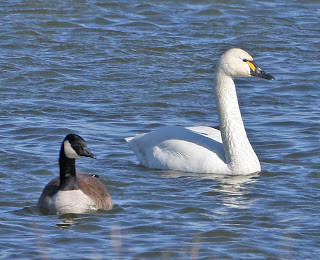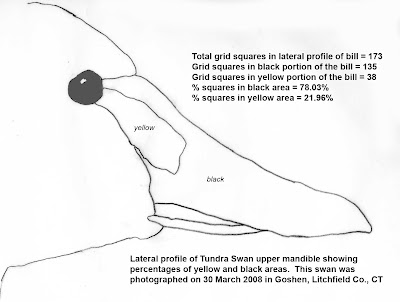This closer position allowed for a better inspection of the birds and I was struck by how much yellow was present on the bill of the adult. A few days prior, I observed four Tundra Swans on a small pond in Eastford, Windham Co., and while the birds were distant, I made notes as to how difficult it was to make out any yellow on the bill. This bird’s yellow patch stood out remarkably well.

Tundra Swan, 30 March, Goshen,
Litchfield Co., CT
I had a discussion with Greg Hanisek, Louis Bevier, and Nick Bonomo about the amount of yellow this bird showed. We discussed the possibility that this could be a Bewick’s Swan, the Asian subspecies corresponding to the North American Whistling Swan. Tundra Swan is comprised of two subspecies, Bewick’s Swan, Cygnus columbianus bewickii, and Whistling Swan, Cygnus columbianus columbianus. Bewick’s is best distinguished from Whistling Swan by the large yellow patch at the base of the bill, often covering the entire basal third of the upper mandible. Whistling Swan typicall shows a small patch of yellow just ahead of the eye on the upper mandible. This patch is small and often difficult to see in the field. Occasionally, there is no yellow present. We all agreed that there was more yellow than we usually see but certainly less yellow than is shown by typical Bewick’s Swan.

Tundra Swan, one of three present on a small
pond in Goshen, Litchfield Co., Connecticut
on 30 March 2008.

Enlargement of the bill showing unusually
large yellow marking.
In July of 2008, I was re-reading an old issue of North American Birds and noted a photograph of Tundra Swans from Washington. These birds showed a similar amount of yellow to that of the March Connecticut bird. In the text, reference was made to an article published in the Auk, the Journal of the American Ornithologist’s Union, wherein a method of quantifying the yellow in the subspecies of Tundra Swans was described. This article also discussed the hybridization of these two subspecies at their natural contact zone. The authors captured a large number of each subspecies and took profile photographs of the bills. They then traced the upper mandible , delineating the yellow area from the black. This tracing was laid over graph paper and the number of yellow squares was compared to the black squares.
Their findings showed that the mean amount of yellow in Whistling Swans was 3.1%. Three percent of their sample of Whistling swans showed no yellow at all and 4.3% had more than 10% yellow on the bill. The largest amount of yellow in a known Whisltling Swan was 15.8%.
Bewick’s swans were divided into three bill-types: Darky, showing a pattern similar to the Goshen bird (17.9% of their sample), Pennyface, with the central black surrounding a yellow spot (19.1% of their sample), and Yellow Neb, the basal third of the upper mandible all yellow (63% of their sample). The mean amount of yellow on the Darky-type Bewick’s Swan Bills was 31.5%. The darkest known Bewick’s Swan bill was 22.9% yellow.
I decided to try this method on photos I secured of the Goshen bird. The best photo I had showed the bird in near profile and I admit that this could build in inaccuracy to my measurement. I enlarged the photo and made a tracing. I laid this over graph paper to quantify the yellow compared to the black. The details of the procedure described in the Auk were lacking and I had to decide how to count squares that showed both yellow and black. I decided to count them as both, feeling that this would eliminate any judgment on my part and make them neutral in the results (I don’t know if this is accurate mathematically but it seemed to work for me).
I counted 38 squares of yellow (including yellow and black) and 135 squares of black (including yellow and black). If any square at the edge of the mandible contained black it was counted as a black square. If any square contained yellow and also contained white as it was against the white of the face, it was called yellow. These numbers worked out to a bill that was 21.96% yellow and 78.03% black. This fell into what the authors described as an intermediate area.

Tracing made from photo diagramming the
distribution of black and yellow on the upper mandible.
Troubled by the assumptions built into my methods, I consulted with Louis Bevier. He told me of a computer program that quantifies an selected area electronically. This program, NIH Image, was installed on his computer and I forwarded him my photograph. On his three attempts, he got measurements of 18.2%, 18.7%, and 18.9% for the amount of yellow. Using his 18.7% as a working average, my square counting method was only 3.26% off. The measurements Louis secured are still in the intermediate range between the two subspecies.
So what does all this mean? Well, the authors of the article in the Auk believe that, using these methods, out of range Tundra Swans can be reasonably assigned to a subspecies. Birds falling in the intermediate range may pertain to intergrade swans, swans from the contact zone between Bewick’s and Whistling. The authors site wild-occurring family groups with each adult belonging to different subspecies.
The Goshen bird? There is not enough yellow to call it a Bewick’s Swan. Is there enough yellow to eliminate a pure Whistling Swan? I am not sure. Certainly, the amount of yellow as quantified by the various methods puts the bird in the intermediate range. If I could have had the bird in a perfect profile I might be more ready to make that type of determination. The Goshen bird showed more yellow than was known from the experience of several long-time eastern birders and a few west coast birders as well. One birder in the west said that a small percentage of the Whistling Swans he sees every year in northwestern United States shows a similar amount of yellow as the Goshen bird. Are these intergrade swans…swans with both Whistling and Bewick’s genetics? Geographically, it would seem possible. There is no way to be certain but the work of Evans and Sladen published in the Auk seems to suggest that this is a real possibility.
Roland Limpert of the Maryland Department of Natural Resources, comments on the Goshen swan, “…The bird in the photo appears to be a Tundra Swan to me based on the amount of yellow. In banding Tundras on the East Coast (Maryland & North Carolina) we would catch birds with a similar amount of yellow not that infrequently and in analyzing more the face photos that we took and banding records we tended to find the Tundras with the most yellow came from breeding grounds on the North Slope and western Alaska. I would say that the bird in the photo was mostly like a Tundra Swan that came from western Alaska.”
This is notable because that origin is where one might expect to see gene flow between the two forms.
I guess I would just call it a really interesting bird.
Remember when, while back in school, you said you didn’t think you’d ever need math in the real world?
Whistling Swan with a typical amount of yellow
on bill. Photo courtesy of Ian Gereg, Avian Director,
Livingston Ripley Waterfowl Conservancy, Litchfield CT.

Enlargement of the bill on the bird shown above.
Typical Bewick's Swan Bill pattern.
Some can show significantly less yellow
than this. Photo courtesy of Ian Gereg,
Avian Director, Livingston Ripley
Waterfowl Conservancy, Litchfield, CT.

Figure 7 Another typical Bewick's Swan
Bill pattern. Photo courtesy of Ian Gereg,
Avian Director, Livingston Ripley Waterfowl
Conservancy, Litchfield, CT.
I would like to thank Louis Bevier, Steve Mlodinow, Dave Shealer of the Waterbird Society, R. Michael Erwin of the USFWS, and Roland Limpert of the Maryland Wildfowl Trust for their help in discussing the identification question, Louis for being a bigger geek than me as he actually owned the quantification software, Ian A. Gereg, Avian Director, Livingston Ripley Waterfowl Conservancy for images of both subspecies, and Joy Mark, Assistant Professor of Mathematics, for showing me the errors of my “gazzinta’s”.
Literature Cited
Evans, Mary E. and William J. L. Sladen, A comparative Analysis of the Bill Markings of Whistling and Bewick’s Swan and Out-of range Occurrences of the Two Taxa., The Auk 97: 697-703, October 1980








